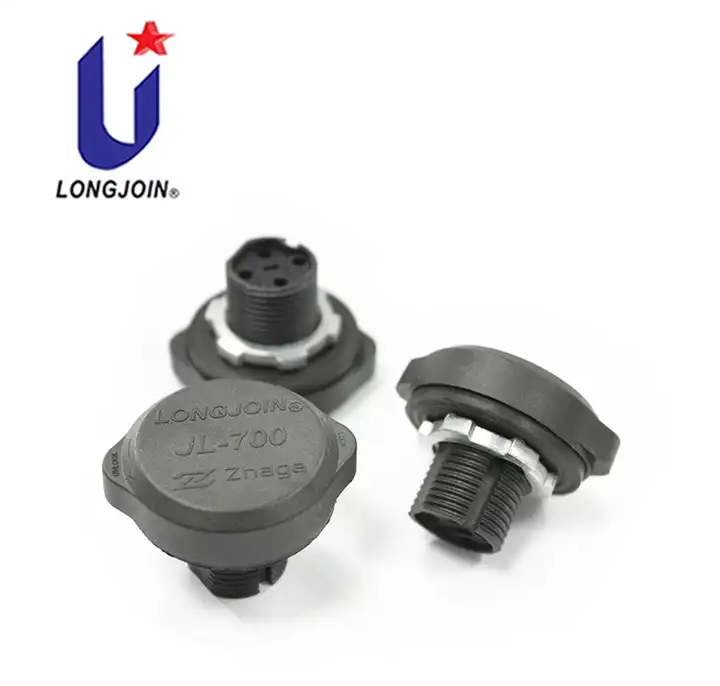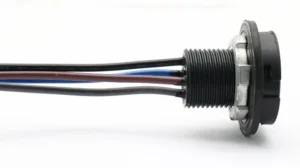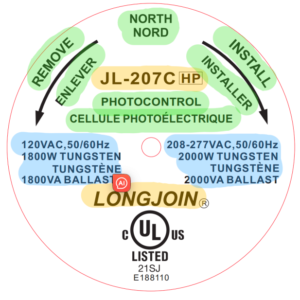(JL-700L Zhaga Book-18 Receptacle (Cable version), by Shanghai Long-join.).
Ensuring Compatibility: The Significance of ANSI C136.41 Standards in Photocell Receptacles
Controlling the lights in your home automatically saves money and energy. Many individuals use photocells to manage their outdoor and indoor lights. However, there is a huge concern when it comes to getting photocell sensors put in your house or at work: Finding the correct Photocell Receptacle.
What is a Photocell Receptacle?
A photocell receptacle is used as an electrical connection for a photocell sensor. It is a socket through which the photocell is inserted or connected. The receptacle usually contains electrical contacts that allow the sensor to control the flow of the outdoor lighting device in response to relevant light levels.
What are the types of Photocell Receptacles
Photocells, whether hard-wired, created with bespoke taps, fitted for LEDS, or simply conventional, will need to be carefully mounted to provide proper light exposure. The best receptacles protect your photocell from the elements, manipulation, and accidental damage while not blocking the light. Depending on your application and fixtures, you may require a particular receptacle for LED photocells.
Some common types of Photocell Receptacles are;
● 3 Pin Receptacle
A 3 Pin receptacle contains only three connections. As seen in the image, there are slots where the photocell prongs can be put to form connections. This links your hot input power to the photocell, the photocell’s output to your light fixture, and the neutral wire, for a total of three connections. When it gets dark, that photocell permits the input power to flow directly to your fixture via the receptacle’s output side, and your light turns on.
● 5 Pin Receptacle
A 5 Pin receptacle is identical to a 3 Pin receptacle except for the addition of two contacts on the receptacle’s surface. These contacts will include two additional wires on the opposite side of the receptacle, which are commonly used to connect to 0-10V dimming leads on an LED driver, but might also be used for other sensors inside the fixture housing on which the receptacle is installed.

(JL-700W No Wires Connect Zhaga Photocell Receptacle, by Shanghai Long-join.)
● 7 Pin Receptacle
A 7 Pin receptacle, like a 5 Pin receptacle, has the same three sockets as a regular 3 pin receptacle, but it also contains four additional contacts on the receptacle’s surface, and four wires on the opposite side. This enables connection to 0-10V dimming in conjunction with other sensors within a sensor enclosure.
Why choosing the right Photocell Receptacle is important
Choosing a reliable Photocell Receptacle can take a weight off your shoulders if you don’t want to deal with the fuss of changing the receptacle again and again or if you want the most efficient lighting system for your project.
A few reasons as to why your choice of Receptacle matters are;
● Compatibility:
Choosing the appropriate Receptacle can guarantee that it correctly interfaces and connects with the photocells being used. Because different photocells have varying voltages, pin configurations, and connecting methods, selecting the appropriate photocell receptacle can help to prevent harm to the photocells.
● Maintenance
Choosing a standardized and widely used photocell Receptacle facilitates lighting system maintenance and upgrades. It also saves time when replacement components are required.
● Safety
It is necessary to take into account the quality of a photocell receptacle because it has a significant impact on the safety of the lighting system as well as the lifespan. When we use a properly designed and good quality photocell receptacle, the danger of a short circuit or electrical mishap is greatly reduced.
Significance of ANSI C136.41 standards in choosing Photocell Receptacle
ANSI C136.41 was issued by The American National Standards Institute. It is a standard that specifies the testing processes for photocell receptacles used in outdoor lighting systems.
The importance of ANSI C136.41 in testing photocell receptacles is considerable due to the following reasons;
● Interchangeable
If we follow the ANSI C136.41 standards, we can make sure that the photocell receptacles from various manufacturers are compatible and interchangeable. This would make for the easy integration and replacement of photocells in outdoor lighting systems.
● Electrical Requirements
ANSI C136.41 specifies the mechanical properties that photocell receptacles must have in order to function safely and reliably. This includes specifications for voltage rates, current carrying capacity, temperature rates, machine dimensions, and environmental factors.
● Durability and Environmental Considerations
ANSI C136.41 specifies the durability and environmental impact of photocell receptacles. It involves tests for moisture, dust, vibration, and temperature fluctuations to ensure that the receptacles can weather the rigors of outside installations and continue to function well for long durations.
By following the ANSI C136.41 requirements, manufacturers, designers, and installers may guarantee that photocell receptacles fulfill uniform quality and performance specifications.
Conclusion
When choosing a photocell receptacle for your photocells it’s important to first consider the format you require. Once this is understood, you will have much more refined options.
Choosing the right type of Photocell Receptacle can simplify the maintenance and upgrades of your lighting system for years to come. There are several types of Photocell Receptacles and each has its own advantages and uses. Some are better suited for your specific needs and thus, can save you both time and money.
If you’re not too rigid about the specifications of your project, you can choose a standardized and commonly used photocell receptacle to get the job done right. Even so, it’s important to consider the quality and the brand warranty of your Photocell Receptacle to save yourself from future trouble. A quality Photocell Receptacle should be compatible with the type of Photocell you use and should help reduce any safety hazard. It should be easy to replace and easy to maintain.
In this matter, ANSI C136.41 provides a reliable set of testing procedures that if followed correctly are bound to give you the best type of Photocell Receptacles based on the compatibility, electrical requirements and environmental factors that come into play when considering your specific project.
If you’re still confused about how to employ the ANSI C136.41 testing procedures and select the best Receptacle for your lighting system, please contact us for free and extensive guidance.






